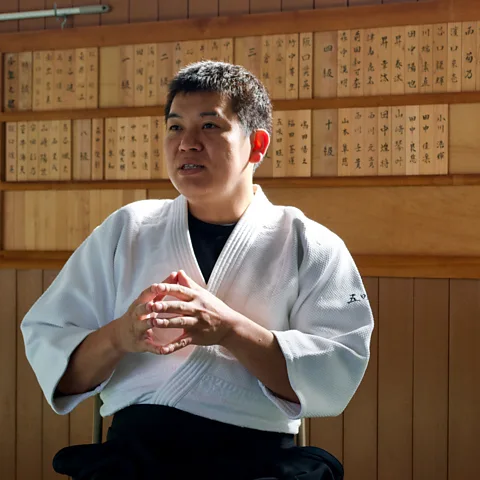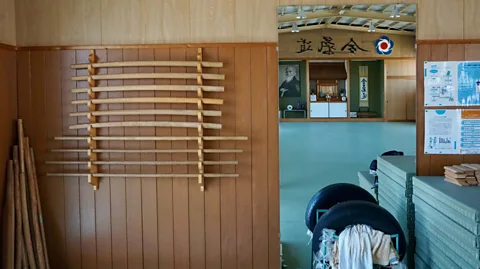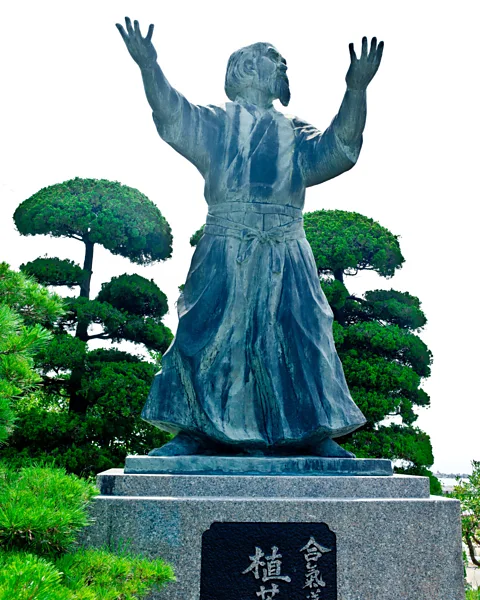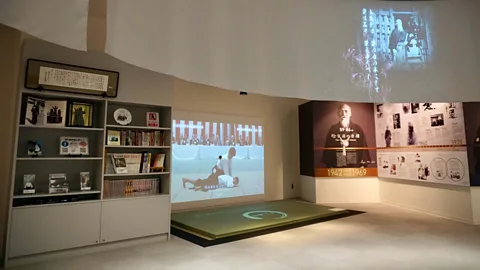Aikido: A Japanese martial art practiced by millions
 Mara Budgen
Mara BudgenEmphasising self-defence rather than victory, Japan's youngest martial art brings both new and veteran practitioners from across the globe to Tanabe, the town where it was born.
Two men stood opposite each other holding wooden sticks shaped like a katana, the legendary Japanese sword, at arm's length. The tips of the sticks crossed each other as the men's gazes locked in a solemn stare.
They raised the sticks above their heads, lowering them firmly – though not violently – to meet their opponent's. This motion, combined with twists of the body and arms, was repeated several times in a sequence so fast that I could only really catch the moment when the wooden implements clashed, producing a sharp thud.
One of the men lunged more decisively, his imitation sword protruding forward. The other deflected the strike, shifting it to the side with an agile spin.
I sat in a trance as I watched the men continue their duel, switching to shorter wooden sticks then to a hand-to-hand confrontation.
The adversaries, Junichi Gomita and Yoshinori Okazaki, were teachers (or sensei) at Aikido Tanabe Dōjō in Tanabe, the town in the Japanese prefecture of Wakayama where aikido's founder Morihei Ueshiba was born in 1883. Created by Ueshiba in the early 20th Century, aikido – meaning "way of harmonising energy" – is one of the youngest of Japan's nine official martial arts, or budō, and Gomita and Okazaki are the latest generation of Tanabe sensei dedicated to spreading this deeply articulated practice and philosophy.
 Mehdi Fliss
Mehdi FlissUnlike other martial arts, aikido's goal is to end conflict non-violently by "matching the opponent's force", Gomita explained, to deflect strikes rather than overpower one's adversary. Aikido is essentially aimed at self-defence; there are no winners or losers, and no competitions are held.
"Ueshiba used to perform aikido for the deities at the shrine near the dojo (training hall)," Gomita said, a task that he has now taken up together with his father, who was appointed by Ueshiba as a representative of the martial art in the 1960s and founded Aikido Tanabe Dōjō in 1981. Mastering aikido is about perfecting choreographed gestures so sublime to be worthy of the gods, and the self-control required stems from the practitioner's inner strength as well as the solidity of their stance.
After Gomita and Okazaki's demonstration, I prepared for my first ever aikido lesson. I joked nervously with my sensei Gomita that it would be impossible to emulate his and Okazaki's effortless grace. He reassured me that everything would seem more feasible once we'd broken the motions down into small, simple steps.
The dojo's smooth green tatami mat felt cool under my bare soles. Gomita instructed me to stand with my feet hip-width apart in a parallel position, then turn my right foot and my body towards the front. We tried moving forward by taking a step with our right foot first, then dragging the left foot behind (and vice versa), as well as turning to face the opposite direction by pivoting on our front foot as our body and back foot spun 180 degrees.
 Mara Budgen
Mara BudgenGradually, we added hand and body gestures and eventually practised with an opponent. All the while, I remained fixated on keeping my footwork light and precise; the smoother this was, the easier the rest became.
Yet I still felt clunky compared to the demonstration I'd witnessed earlier. I asked Gomita and Okazaki how long it normally takes for the movements to feel natural. "It depends on the person," Okazaki said, "for example, I started this budō in my 30s and it's always felt effortless. Aikido is about receiving the other person's energy, like when children clap each other's hands; it's as natural as child's play." Gomita, on his part, has never known a life without aikido. "I've been doing it for as long as I can remember," he said.
Gomita, in fact, comes from what can only be described as an aikido family. His mother Yukiko, now in her late 60s, began practicing at 14. "My father was very strict about me having a curfew, but when someone suggested that I practice aikido at night, he agreed," Yukiko recalled, as we chatted after my aikido session. Her teacher went on to become her husband, Gomita's father. "He taught me about the importance of practicing hard during training because no one can guide you once you're on that stage. That idea stuck with me," she reflected.
I asked Gomita what his father had told him about his own sensei, Ueshiba (Gomita was too young to meet the master, who died in 1969). "Ueshiba was friendly and open-minded, but when practicing aikido, he would transform, becoming a much stricter and fiercer version of himself," he said. As Gomita spoke about Ueshiba, I couldn't help but look at the giant black-and-white photo of aikido's founder hanging at one end of the dojo.
 LaChouettePhoto/Getty Images
LaChouettePhoto/Getty ImagesAfter the session, Gomita and I visited Morihei Ueshiba Memorial Museum, located in the same building as Tanabe's municipal martial arts arena, about 3km from Aikido Tanabe Dōjō. The museum was small but packed with information. Opened in 2020, its state-of-the-art video displays even features an interactive station to learn aikido.
"Across Japan, 30,000 signatures were collected to petition Tanabe Council to open the museum," explained Gomita, who was involved in its design.
As I wandered around the exhibits, I was catapulted into Ueshiba's extraordinary life. He lived all over Japan, including settling for a period in the northern expanses of Hokkaido to set up a farming community. In his youth, he'd mastered karate and judo but had found them to be too competitive. "So, he took aspects of both to fashion a martial art that suited him," Gomita told me, adding that he eventually settled on the name "aikido" in 1942.
Initially, Ueshiba was mainly devoted to his own training and took on few students. Despite standing at just 156cm tall – as a life-size photograph in the museum demonstrated – he could neutralise much larger opponents, and even multiple ones at a time. "[Yet] aikido isn't about defeating one's enemy," Ueshiba emphasised, "it's the way to unite human beings."
 Mara Budgen
Mara BudgenThis sense of aikido as a community, rather than an individual pursuit, was also apparent in Yukiko's words. "What I like about this practice are the bonds that form between people on and off stage," she told me. "At first, it could seem like it's all about making your opponent fall, but real aikido is about taking care of and connecting to others."
Ueshiba's son encouraged him to start demonstrating his creation in front of others, and in 1956, aikido's founder invited people, including from abroad, to witness the first demonstration to be held after World War Two. The discipline thus spread not only throughout Japan but overseas, and today, millions of people practise this martial art in more than 100 countries.
Perhaps nowhere though is it more ubiquitous than in Tanabe. Martials arts are taught in Japanese schools as part of the physical education curriculum, and in this town "11 out of 14 middle schoolers take aikido classes", Gomita said. "I know because I teach most of them," he added with a chuckle.
Furthermore, Gomita mentioned that aikido practitioners from around the globe flock to Tanabe, including to his dojo, which also has 20 regular students, all adults, including six women. "Beginners are welcome too, but if they don't speak Japanese, they might struggle," Gomita pointed out. "So, we recommend that people book the tour offered by Tanabe Tourism Bureau that includes a private aikido experience with interpretation."
During the aikido session, Gomita taught me to move with grace, self-awareness and intention – in contrast to how I usually go about life, which is frantically and often without a real purpose. "It also felt meaningful to spend time in Tanabe, rather than just pass through, like many people do when they're walking the Kumano Kodo [a Unesco-inscribed pilgrimage route that is this region's main attraction]," said Kanae Watari, who had come from another part of Wakayama to join the session.
 Mara Budgen
Mara BudgenTo round off my visit, I went to Tanabe's Kozanji temple, where Ueshiba is buried. In a corner of the Buddhist temple's vast cemetery, a large stone memorial bearing Ueshiba's name and the word "aikido" stood next to a smaller tombstone surrounded by pots of freshly cut branches.
I watched the sunlight flutter on the stone monument as the wind moved the surrounding trees. I felt privileged to have experienced Ueshiba's philosophy in the place of his birth and hoped that aikido's teachings would help me tackle the challenges of daily life. I resolved to embark on this new chapter by taking small, deliberate steps towards a more harmonious version of myself.
---
Join more than three million BBC Travel fans by liking us on Facebook, or follow us on Twitter and Instagram.
If you liked this story, sign up for the weekly bbc.com features newsletter called "The Essential List". A handpicked selection of stories from BBC Future, Culture, Worklife and Travel, delivered to your inbox every Friday.
